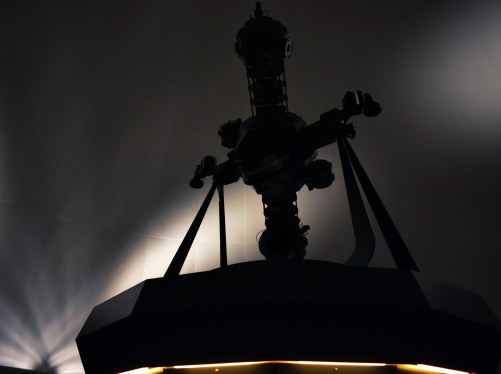Staerkel Planetarium Presents Astronomy Shows – Prospectus
by: Erin Morrison
32 years after it first opened, Parkland’s William M. Staerkel Planetarium is still going strong.
If you want to see a show at the planetarium, there are two every Friday and Saturday night.
At 7 p.m. on Fridays, you can see, “Fall Prairie Skies,” a show that is updated seasonally and informs about what constellations are visible that night. At 7 p.m. on Saturdays, “Solar System Safari,” a show for kids that teaches about the Solar System is available.
On both Friday and Saturday nights at 8 p.m., the “Dark Matter Mystery” show is presented. This show explores the concept of what “dark matter” really is. On the first Friday of every month at 7 p.m., instead of playing “Fall Prairie Skies,” there are James B. Kaler Science Lectures where scientists talk about their research.
Student prices are $5 for one show, $7.50 for two shows, and $2 for the science lectures. More details are available on the planetarium’s website. (parkland.edu/planetarium)
Outside of the regular schedule, the planetarium has some special events on days like Smithsonian Museum Day and Columbus Day. In December there are always holiday shows.

Recently, on Oct. 9, the planetarium played the movie, “Chesley Bonestell: A Brush With The Future,” which was sponsored by the Giertz Gallery. Bonestell is a science fiction artist. Before the showing there was also a Theremin performance in the planetarium’s lobby.
How is it decided what shows are debuted at the planetarium? Erik S. Johnson, Associate Professor of Natural Sciences at Parkland and since July of 2019 and the director of Staerkel Planetarium, along with the planetarium staff will collaborate to discuss what shows people would be interested. Johnson said that, “We make sure to see the shows for ourselves to make sure they’re worthwhile. We try to consider what we think the public will be interested in. We often want to skew towards making sure that it has scientific value to it.”
Licenses to the shows need to be purchased for the planetarium to be able to play the show. These licenses can last 50 years. This means that they sometimes choose to replay shows that they have not had in a while. “Maybe somebody missed it the first time or someone wants to see it again,” Johnson said.
“The Planetarium has had many upgrades since its founding in 1987. It was named for Parkland College’s first president, William H. Staerkel”
Some of the shows they play now would not have been possible for them to do with a special software upgrade to the projector systems last fall. The projector systems were originally installed in 2010, replacing what many people who grew up in the area have known as “Carl.” Carl, named for the German creator Carl Zeiss, is still in the planetarium, but is no longer used for shows. Carl used a complex system with lots of slides and lighting and could show how stars and the solar system looked from Earth. Now with the projector system, the planetarium can even show the view from Mars.
The Planetarium has had many upgrades since its founding in 1987. It was named for Parkland College’s first president, William H. Staerkel. Johnson said that Staerkel had wanted there to be a “cultural center” on the west side of campus. After waiting 15 years for the funding, the planetarium and the theater were built. Staerkel Planetarium is now the second largest planetarium in Illinois.
In the future, the planetarium is looking forward to serving new audiences. Johnson said that, “I’m very interested in seeing what shows we can offer to Spanish speaking audiences.” Johnson also mentioned that reintroducing Pink Floyd and laser shows is a possibility.
For more information about the Staerkel Planetarium, please visit the planetarium website.






